Skin lesions on the infant and baby skin
This post was written by Dr. Pleimes, a specialist in pediatrics, dermatology and allergology
Click here to read further information about Dr. Pleimes.
Since a baby’s skin is still very sensitive, skin changes can occur more quickly. Dry, reddened and irritated skin areas are therefore not uncommon. For example, there are red spots around the mouth, pimples on the face, a sore and itchy baby bottom or red dry patches on the body. In this article you will learn what these skin changes are and what you can do about them.
You are unsure how to properly clean and care for your baby? Then read this post!
Skin changes on the face
Salivation during teething and redness around the mouth
During teething, the newly growing milk teeth break through the gums. This is a normal stage of development for your baby. A baby’s first tooth usually appears between 5 and 7 months of age. Some babies get their first tooth a little earlier, others a little later.
The 2 middle bottom teeth often come first. Then the middle 4 upper teeth. By the time the baby is about 2 ½ years old, all the baby teeth, 20 in number, are usually in place.
Accompanying the eruption of the first teeth is often increased salivation. Children put their fingers or hand in their mouth more often. But even without a new tooth, babies like to put things in their mouths. This also spreads saliva on the skin, which can then irritate the skin. The skin then appears red and irritated. Most often, the skin around the mouth and, due to saliva running down, the skin on the neck is also affected.
Teething can also be painful and cause swollen areas on the gums. It can be helpful to offer your baby a refrigerator-cold teething ring at that time. If the problem is very pronounced, pain-relieving adhesive gels or medications may also be used.
The skin around the mouth can be protected from excessive irritation by careful cleaning and application of a skin-protecting care cream.
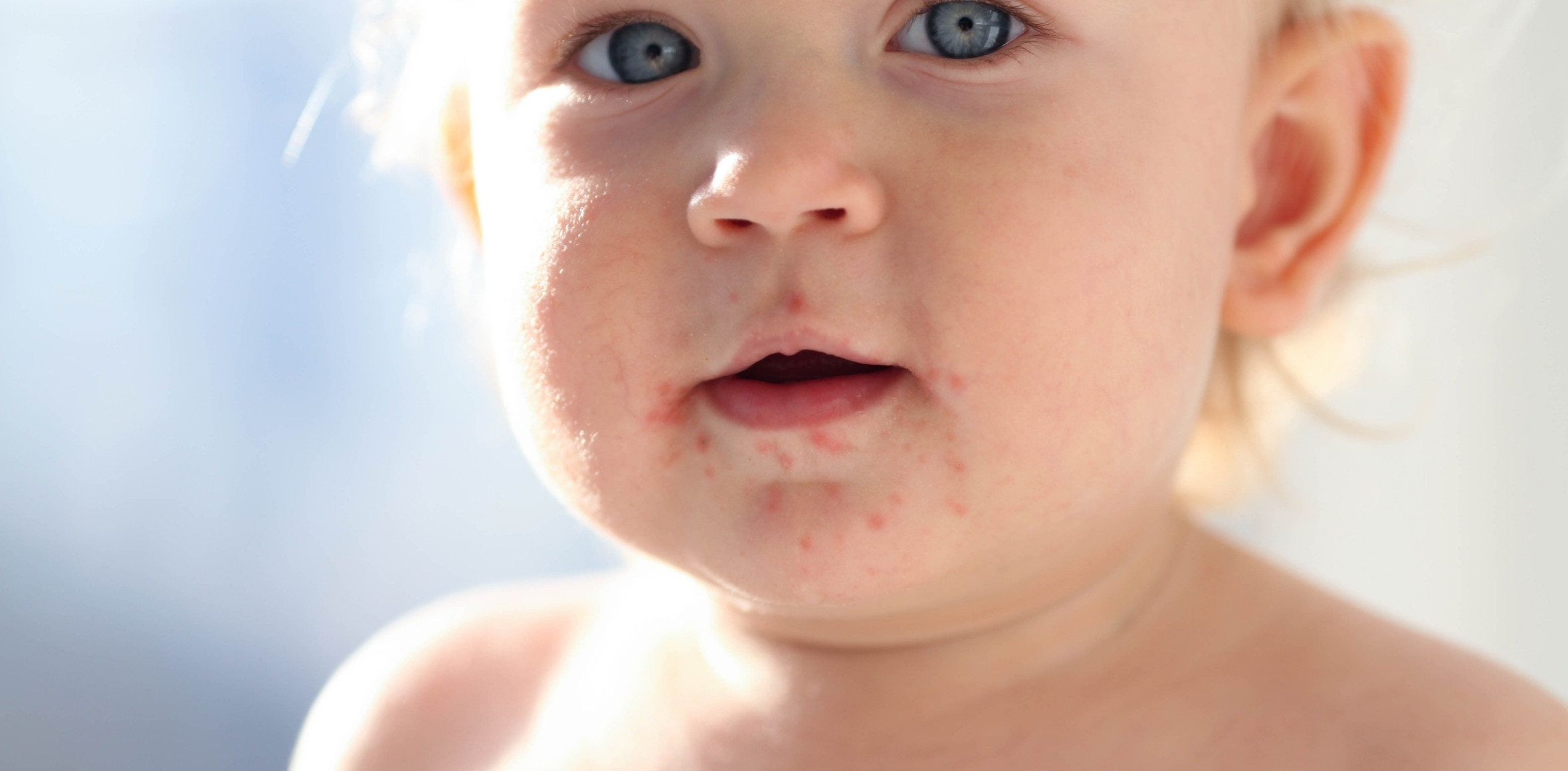
Reddening of the skin around the mouth
If your baby is already receiving complementary food, food components as well as saliva can lead to reddening of the skin / red spots around the mouth. In most cases, these are not real allergies, especially if there is only local redness around the mouth. Various foods such as tomato or certain fruits can release histamine or have similar irritating effects in the skin they come in contact with. This causes fine skin vessels to become more perfused and the skin to appear red and irritated. This process is also harmless and depends on the amount and duration of contact. Treatment is usually not required.
Urticaria
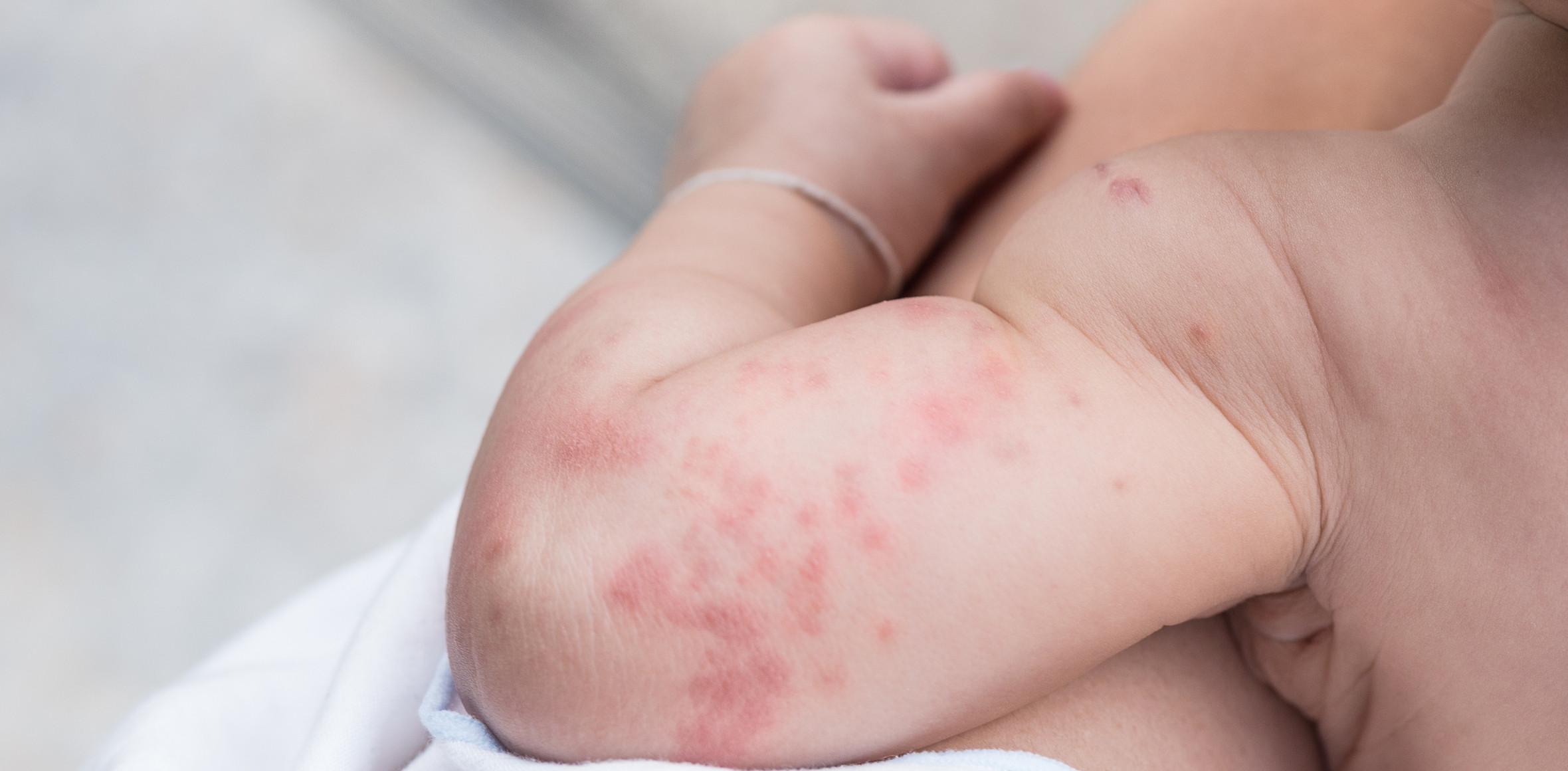
Rarely, true allergic reactions can also occur after ingestion of food. These are usually more pronounced and typically lead to more extensive reactions shortly (a few minutes) after contact with / or consumption of the food in question, e.g. with the development of wheals also on other more distant parts of the body. We then speak of hives or urticaria. Similar reactions can also occur in the context of an otherwise harmless infection. In these cases, the pediatrician can classify and treat the condition.
Pimples on baby’s skin
In the first month, papules and pimples can develop on the skin, especially on your baby’s face. Although this is usually referred to as newborn acne, there are various causes behind the small pimples.
True acne is probably less common than a reaction of the skin to yeast colonization (hair follicle inflammation due to Pityrosporum colonization) or an excessive inflammatory reaction of the areas rich in sebaceous glands (seborrheic dermatitis, see below).
In all these reactions small pimples, sometimes also yellowish filled pustules can develop. Only in the case of true neonatal acne, however, additional blackheads (comedones) also appear.
All these skin changes have in common that strongly oily creams, ointments or oils for care can worsen the findings on the face. Only light and primarily water-based skin care products should be used here. However, most of these early skin changes do not need to be treated and disappear by themselves in the course of the first 2-3 months.
Redness and spots in the diaper area
Reasons of a sore and itchy baby bottom – diaper rash
Inflammatory irritation in the diaper area occurs in almost all infants and toddlers at some point.
The most common form is a so-called irritative-toxic diaper dermatitis, in which an irritative inflammation of the skin occurs due to unfavorable environmental milieu: stool, urine and germs. This diaper rash / diaper dermatitis is common and is accompanied by red spots and inflamed skin on your baby’s bottom and lateral genital area. The spots can also be weeping and open at times. There may also be itching or painful findings, which can manifest itself in restlessness and crying during diaper changes.
Causes are the still very sensitive skin barrier and especially prolonged soaking and stool contact with the skin (e.g. when diapers are not changed so frequently) as well as damage to the acid mantle of the skin. Friction is also an additional irritant.
The redness in this form of diaper dermatitis is typically in the area of skin-diaper contact. Direct skin folds are often unaffected or only slightly affected.
Diaper dermatitis may be aggravated by:
- Prolonged contact with wet, possibly soiled diapers, including, for example, diarrhea or very frequent bowel movements.
- Chafing and friction from ill-fitting diapers or tight clothing.
- Additional irritation due to change in stool consistency or composition, e.g., with introduction of new food or infections.
- Irritation due to ingredients in skin care products or skin cleansing products.
- Miscolonization of skin germs, e.g., after therapy with antibiotics (may also lead to favoring and proliferation of yeasts such as Candida on the skin with subsequent diaper fungus).
Complications of diaper dermatitis may include bacterial and candida infections on the pre-damaged skin. Pigmentary shift of the skin may also result from the inflammation, which is more common in more pigmented skin types.
Prevent diaper rash
The best way to prevent diaper rash is to keep the diaper area clean and dry. A few simple strategies can help prevent diaper rash:
- Change diapers frequently: remove wet or stool-filled diapers as soon as possible. If your child is in child care, ask staff to do the same. Disposable diapers with super absorbent properties are superior to cloth diapers in this regard.
- Wash the diaper area with warm water after each diaper change, adding a gentle skin cleanser if necessary. Sensitive wet wipes can also be used on the way. Unnecessary additives such as fragrances should be avoided.
- Carefully dab the skin dry with a clean towel or allow it to air dry. Stronger rubbing is not advisable.
- A diaper care cream or paste can then be applied to the area. Powders should not be used. If the area is highly red and/or oozing, pastes that can absorb some water/moisture are helpful. If the skin in the diaper area is not very red or inconspicuous, nourishing diaper creams, zinc ointments or even a soft zinc paste can be used.
- Wash your hands well after changing the diaper to avoid spreading germs to other parts of the body.
- The diaper should not be too tight. Tight but loose. This allows more air circulation and also avoids irritating rubbing.
- If time permits, leave your baby without a diaper once in a while. Exposing the skin to air is a natural way to let it dry. If your baby plays and crawls on a large towel, possible “accidents without diapers” are not problematic.
If your baby’s skin does not improve after a few days of treatment at home, you may need to see a doctor. There may be an additional problem or another cause, or the therapy may require additional prescription medication for treatment.
Diaper fungus / diaper thrush
Sometimes when there is redness in the diaper area, it is due to a fungal infection caused by yeasts. Yeasts are found as germs in our environment and also on our skin. However, sometimes these yeasts can multiply to the point of causing a skin infection. The area covered by a diaper is at risk for this, as it is warm and moist and a good breeding ground for bacteria and yeasts. Typically, the skin folds are also affected here and small pimples and pustules (satellite foci) then exist around the folds or towards the edge of the inflamed area. The causative germ is usually Candida albicans. In addition to the therapy, as it is done in case of an irriative diaper dermatitis, an antifungal cream or paste is now necessary for treatment.
If diaper fungus exists, the child’s mouth should also be looked at. Again, yeast can cause a coating on the tongue and cheeks. This should then be treated as well.
Dry baby skin
After your child is born, its skin initially loses a lot of the moisture that was present in the upper skin layer in the womb due to the amniotic fluid. The process of adapting to the now dry environment often leads to desquamation of the hands, feet and possibly the entire body in the first few days. This natural desquamation (also called physiological desquamation), which usually occurs in the first 10 days of life, is harmless and does not need to be treated. However, the condition can be improved by a mild care cream.
Sensitive and reddened baby skin
The skin is still increasingly sensitive to barriers, especially in the first months of life. The outer skin layer is still more permeable than is the case with older children. In addition, the skin is exposed to a variety of new external environmental factors.
Reddening of the skin can occur in areas with a higher sebum content, such as the scalp and face, or in warm, moist areas of the skin and skin folds, presumably due to an increased occurrence of otherwise harmless skin germs such as certain yeasts. This is known as seborrheic dermatitis.
Seborrheic dermatitis
Reasons & occurrence of seborrheic dermatitis
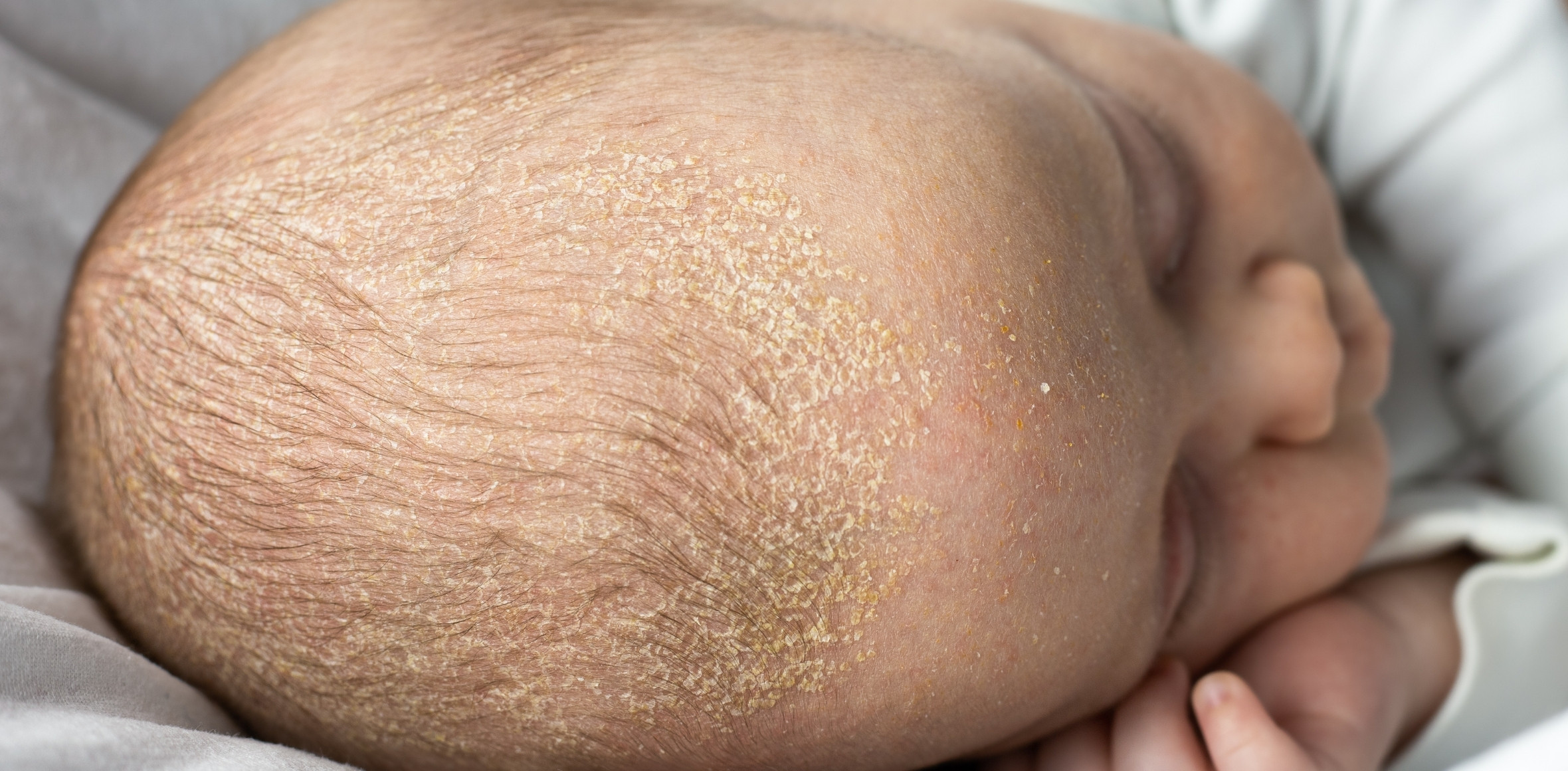
Infantile seborrheic dermatitis is a common skin disease in infants, which typically occurs in the first 1-3 months of life and usually resolves rapidly usually after weeks, possibly after 6 to 12 months max. Affected areas are mainly the scalp as scalp gneiss or the diaper area, sometimes eyebrows, forehead, temples and the area around the nose as well as ears. Rarely, the skin may also be affected over a large area.
Seborrheic dermatitis of the scalp begins with the scalp being covered with greasy, yellowish, waxy scales. The eyebrows may be scaly, but the forehead and skin folds may also be red.
If the scalp is strongly affected, the scaling rather dry, the underlying skin strongly reddened and there is itching an early atopic dermatitis/neurodermatitis may also be present. Especially if there is also a positive family history for allergies. This is then referred to as cradle cap.
In the diaper area, seborrheic dermatitis usually affects the groin (skin folds – in contrast to irritant diaper dermatitis). Here, too, the redness may be more extensive. Small, white skin flakes may be present. However, the moist friction of the diaper often causes these to come off, leaving reddened more shiny skin. The redness may extend into the skin folds on the thighs, around genitals, and on the buttocks.
Slightly red, scaly, non-itchy areas may also be present on the body.
The cause of seborrheic dermatitis is thought to be increased sebum production and colonization with yeast germs (Malassezia). However, seborrheic dermatitis is not contagious, even though germs stimulate our immune system to form increased inflammatory reactions.
Any inflammation of the skin leads to an additional increased sensitivity of the upper skin layer and this can rarely facilitate a skin infection, for example by Candida germs. Clinically, small pustules and papules then usually exist in addition to the extensive redness in the peripheral area.
Bacterial superinfections, especially in skin folds, are also possible.
Treatment of seborrheic dermatitis
Seborrheic dermatitis is not dangerous and affected children have no itching and are not impaired. Especially in less pronounced forms, there is no need for therapy and spontaneous resolution can be expected within a few weeks to a few months.
In infants in whom the condition does not resolve on its own, some simple treatment measures can be taken:
- Application of little oily, more watery creams (no fatty creams or ointments).
- Careful skin cleansing with mild baby cleansing lotion or mild unscented baby shampoo.
- Gently massage the scalp with fingertips to remove crusts and excess dandruff but without irritating more by rubbing.
- Use a soft brush to gently loosen dandruff.
- Dandruff can also be loosened in advance by the application of greasy creams or oils (apply only just before bathing), which will facilitate removal.
- Skin fold areas and the diaper area should be kept clean and dry.
- Regular diaper changing is also a proper measure in seborrheic eczema, as in diaper dermatitis.
Once the inflammation is very pronounced, further measures such as mild anti-inflammatory lotions or preparations working against yeasts can also be prescribed by the doctor.
Infant atopic eczema
Reasons & occurrence of infant atopic eczema
If dry redness with scaling is present and itchy or weeping findings also occur, a transition or the presence of atopic eczema may also be present. Especially in the first months of life, the itching may be less pronounced, which makes it difficult to distinguish it from seborrheic dermatitis. Simultaneous existence or transition of seborrheic dermatitis and atopic eczema is also possible.
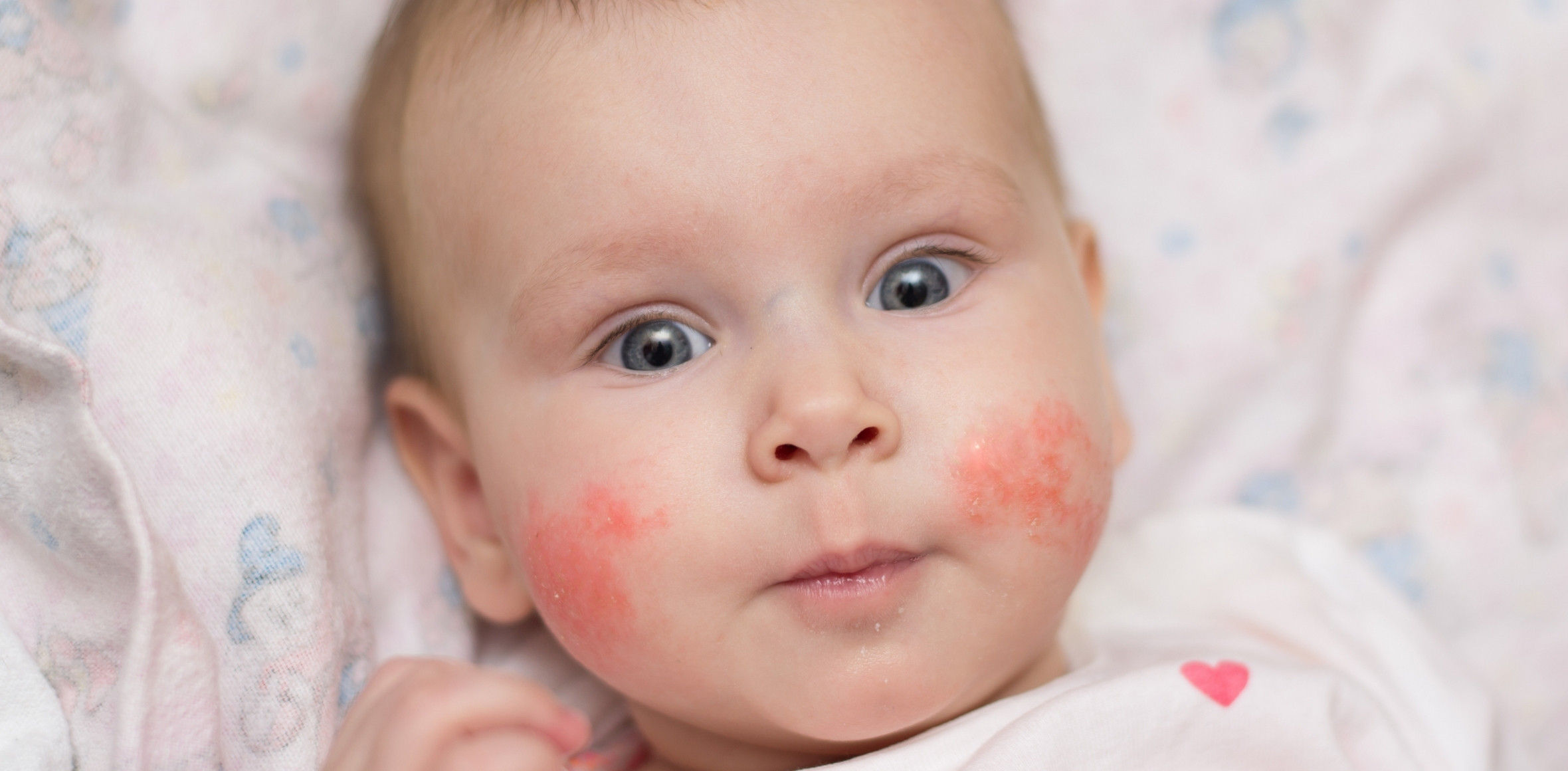
The cheeks are often affected first in atopic eczema. However, basically all areas of the body can have spots. In infants, the later typical areas such as the large bends are often not yet affected. On the arms and legs, we also find inflamed skin on the extensor sides. In contrast to seborrheic dermatitis, the diaper area is usually not affected.
In the case of atopic eczema, the cause is a skin barrier that was created from birth and is increasingly sensitive. Different factors in the environment: bacterial colonization of the skin, friction, sweating, irritation by saliva, soaps, increased dehydration due to dry winter air or after swimming, etc. lead to regular irritation of the immune system located in the skin. When these defense cells begin to react, redness and scaling of the skin develops, as well as usually accompanying itching. We call these changes eczema. A therapy should always be given here, because it is a skin disease, which can cause increasing problems (sleep disturbance, scratch scars, skin infection) if the inflammation is left. Among other things, a vicious circle is started by the reaction: the increased skin sensitivity first leads to inflammation due to irritation – the inflammatory reaction in turn further damages the skin barrier – this in turn leads to easier further irritation and thus often intensification of the symptoms. This process can become chronic if the condition persists for a long time.
Treatment of infant atopic eczema
Regular basic skin therapy is important for affected children. Bathing with skin-friendly cleansing lotions or bath oils (this can be done daily), always followed by a skin barrier-improving care cream, additionally stabilizes the increasingly sensitive skin barrier. If an inflamed area of the skin is present, however, this alone often cannot break the vicious circle mentioned above. The aim of basic therapy is above all to prevent new eczema from developing. In areas of the body where eczema persists despite regular basic care, your doctor should also administer anti-inflammatory therapy. If the inflammation is controlled by this, the skin can better regain its natural balance and can thus be better kept stable by the above-mentioned basic therapy.
In children who are prone to atopic eczema, however, inflammation will occur repeatedly, as expected, especially in the first years of life, since new irritations are sometimes stronger, sometimes less, depending on the environmental situation. As your child grows older, skin stability increases and the tendency to eczema improves.
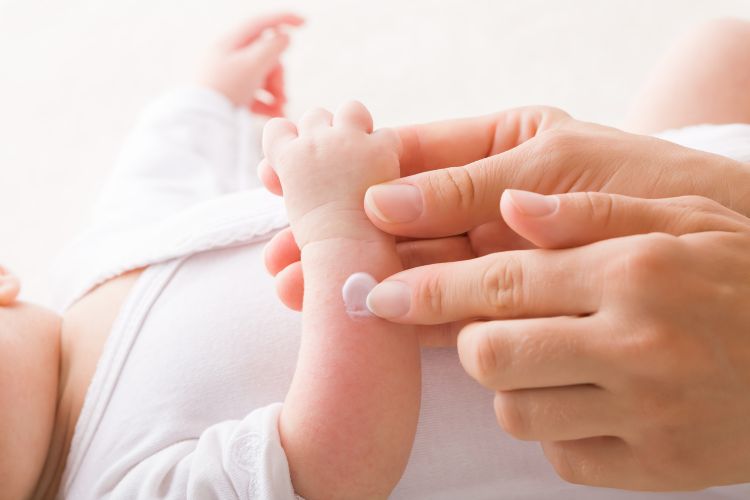

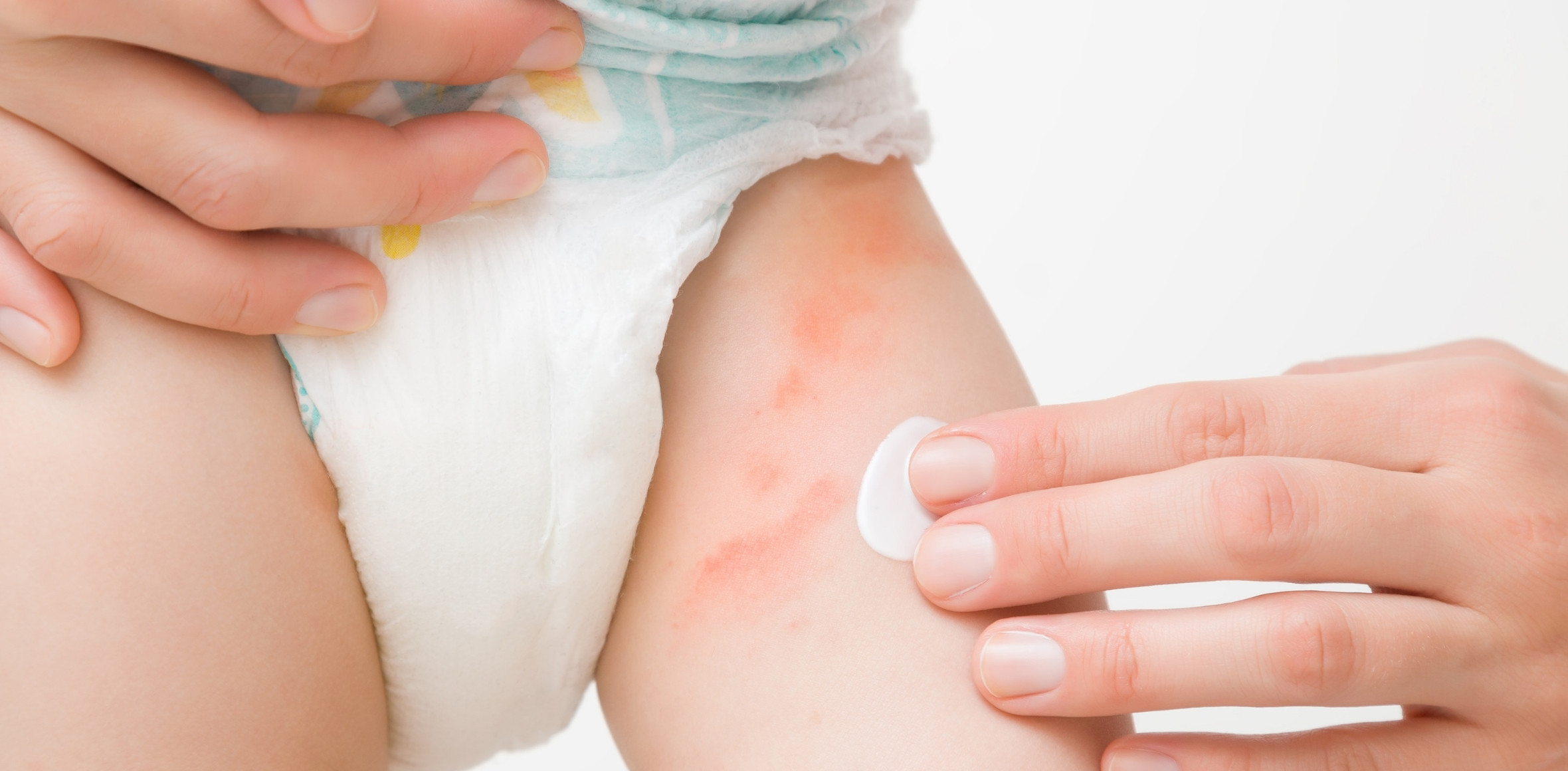
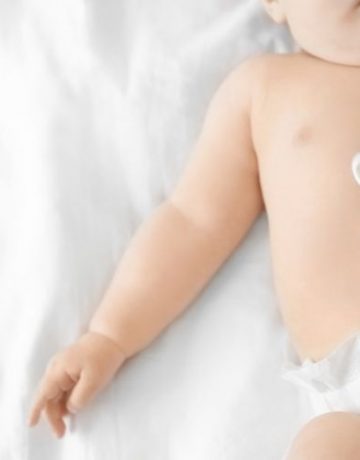
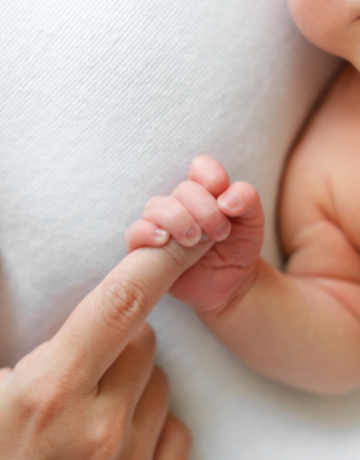

Comments (0)